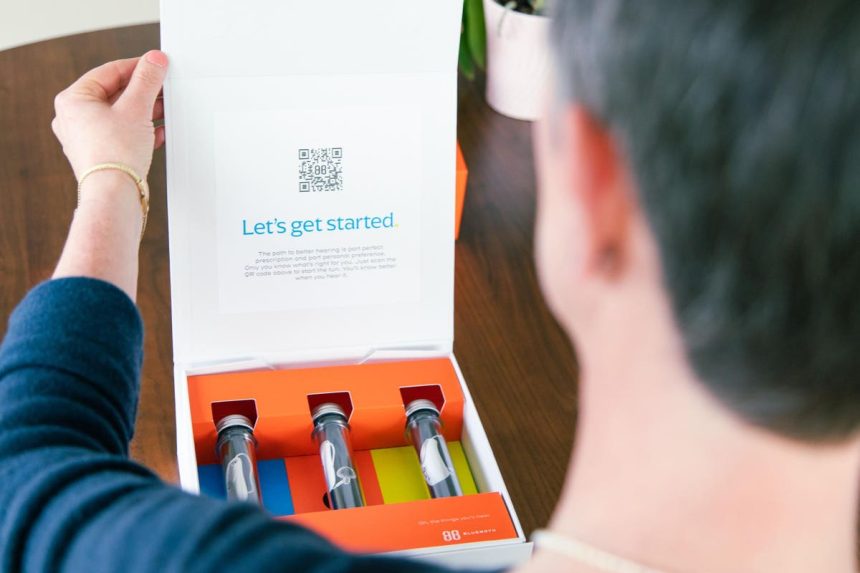Back in late January, I covered hearing aid startup Orka. Take one look at the hero image and it’s not hard to see the company’s device looks a lot like AirPods—and that’s all by design. Orka co-founder and chief executive Ben Sun told me in an interview at the time one of his company’s primary goals was to make hearing aids as cool as AirPods; to make hearing aids something a person would want to wear for coolness sake rather than begrudgingly so for medical reasons. Indeed, as technological progress has marched ever forward, hearing aids have slowly but steadily become more computer-like than ever before. Not only can they address a person’s audiological needs, they also can do other things like stream music, podcasts, and much more. Like AirPods, medical grade hearing aids can be bonafide computers for your ears.
It turns out, Sun isn’t the only ones who thinks hearing aids can be cool.
In a press release published on Wednesday, Seattle-based hearing health startup Bluemoth announced what it described as “a virtual destination that gives users the freedom to discover and shop for premium hearing technology, all from the convenience of home.” The company reiterated its steadfast commitment to making hearing wellness “radically personal” by giving prospective consumers access to what it calls expertly curated and cutting-edge prescription hearing technology.
Bluemoth’s model works by asking customers to upload their prescription on the company’s website; after being reviewed by an audiologist, shoppers receive three hearing aids with their exact prescription for a home trial period. After the 45-day trial ends, people return to the Bluemoth website to purchase the set they like best.
For Dr. Melanie Hecker, an audiologist and Bluemoth’s founder and chief executive officer, her company’s work is reflective of how hearing aids have increasingly gone from sterile medical device to cool status symbol. In a recent interview with me over videoconference, Dr. Hecker explained there has been a “massive transition” in how capable hearing health technology is and, by extension, how cool hearing aids can be. Bluemoth, she told me, was created in part to help address some of the challenges and problems with hearing health and “how to flip the script for consumers.” According to Dr. Hecker, the biggest problem with devices like conventional hearing aids, and hearing health in general, is the stigmas associated with any semblance of hearing loss. Hearing aids, she said, are “beige and boring” and the process for getting fitted for one isn’t exactly pleasant. Likewise, she said hearing loss oftentimes is associated with getting older and obviously not a desirable trait. Having a disability herself—she has what she called a “severe” visual impairment—Dr. Hecker is particularly sensitive and empathetic to these feelings. Bluemoth, she told me, exists to push back on all these tropes.
Indeed, caring about hearing health, as with mental health in context of the pandemic, has seen more heightened awareness in recent times. “That [the importance of hearing health] to me is something I really want to bring a lot more awareness to, because there are so many benefits to having your hearing corrected and to be able to live as optimally as possible,” Dr. Hecker said. “Not only is it helping your hearing system, but it’s helping your overall brain health.”
Beyond the societal stigmas around hearing health and hearing aids, another big issue Dr. Hecker and team are trying to address is cost. From a financial perspective, hearing aids are expensive and most insurance plans don’t cover much of the costs, if at all. This reality is part of Bluemoth’s value proposition, insofar as the company lets users to try hearing aids first rather than spend thousands of dollars—money a person may not have—on something they may not like. Everything about Bluemoth’s model is “radically different in the world of audiology,” according to Dr. Hacker. “Very rarely are you able to even try something before you commit thousands of dollars to purchase,” she said.
In terms of feedback, Dr. Hecker said it’s been positive and reiterated the notion that more people nowadays are making preventive health a high priority. “I think there’s a big focus on [staying] as well and healthy as possible as an individual in every single way,” she said. Moreover, Dr. Hecker shared an anecdote about a woman who recently got hearing aids through Bluemoth and was impressed by its technical chops. The woman, Dr. Hecker told me, openly wondered what to do with her AirPods after learning her hearing aids could stream music and podcasts too. While hearing aids and earbuds like AirPods remain fundamentally different, the center portion of the proverbial Venn diagram is getting closer than ever before. Add in the fact most modern hearing aids now have an AirPods-like charging case instead of traditional batteries, and it’s easy to see the appeal in these cooler hearing aids. In the words of Dr. Hacker, today’s hearing aids are essentially “little computers” capable of doing much more than their beige and boring ancestors.
Looking towards the future, Dr. Hecker anticipates hearing aids being even more capable as technology evolves, as well as preventive healthcare becoming even more en vogue. There is great accessibility, she told me, in having the freedom and the power to take control of one’s health from your own home—and at lower costs to boot. With Bluemoth, she added, customers aren’t merely getting experts audiological guidance; they’re a getting top-flight shopping experience as well.
“I think this is the really big push: to marry those things—freedom [of choice] and fun and greater accessibility—but also make sure that consumers are being taken care of in the most appropriate way given their their [medical] needs,” Dr. Hecker said.
Read the full article here










